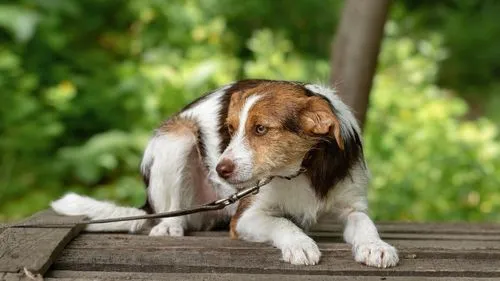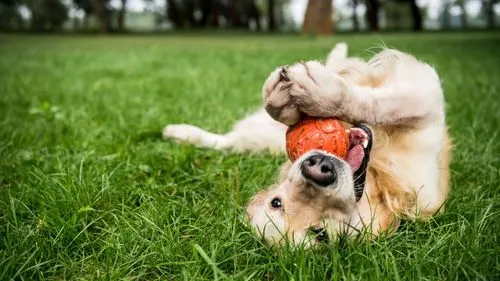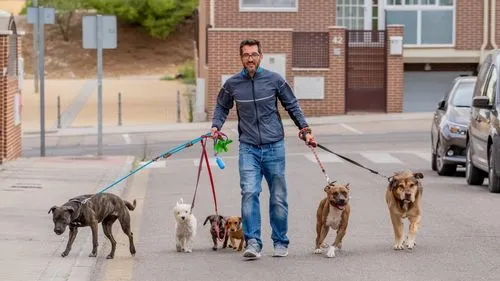How long can a dog be left alone? All you need to know
May 22, 2023
Katka

As fellow dog lovers, we all understand the importance of home – a haven of comfort, security, and unconditional love. But what happens when we're away? How long can our loyal companions be left alone? This question carries more weight than you might realize. So let's buckle up and dig into the world of dogs and their experience of solitude.
Balancing the demands of work, personal life, and dog parenting can feel like walking a tightrope. But once we decode how long our dogs can be left alone, we're one step closer to achieving that delicate balance.
Age isn't just a number
Age plays a significant role in how long a dog can be left alone. Different stages of life come with different requirements.
1. Puppies
As adorable as they are, puppies are a handful. Similar to human babies, they require a lot of care, nurturing, and attention. Puppies under six months should not be left alone for more than two hours a day. Little Fido's small bladder won't last long, and his curious nature means he's always on the lookout for the next great adventure (which might not be safe!).
2. Adult dogs
Adult dogs (1-8 years old) can handle about four to six hours alone if they get enough exercise and mental stimulation. Imagine this: you took Max, your two-year-old Labrador, for a nice long walk and he played to his heart's content. You leave him his favourite chew toy and head off to work. It's likely that Max will spend much of your absence sleeping.
3. Senior dogs
Getting old is a fact of life, and with it come certain challenges. Senior dogs may need to relieve themselves more frequently, similar to puppies, and may also have health problems that require attention. Old Lady Bella, your faithful 12-year-old German Shepherd, might have arthritis and require medication every few hours. Leaving her alone for long periods could increase her discomfort and anxiety.
All breeds are not created equal
The breed of your dog can significantly impact their ability to tolerate being alone. Just as we humans have our unique personalities, different dog breeds have varying characteristics that influence their independence.
Lone warriors
Some breeds, like Basset Hounds, French Bulldogs, and Chow Chows, are known to handle solitude better than others. These breeds, fondly referred to as 'lone warriors,' are akin to the introverts of the dog world. Think of your friend's Chow Chow, Rufus. He enjoys his alone time just as much as his cuddle time.

Velcro dogs
On the other hand, breeds such as Border Collies, Labrador Retrievers, and German Shepherds, often dubbed "velcro dogs," thrive on companionship. They tend to form strong bonds with their humans and might have a hard time dealing with their absence. Such dogs follow you everywhere, from the bathroom to the garden, and are always looking forward to fetching or belly rubs.

Distress signals - reading between the lines
Just because our dogs can't verbalize their feelings doesn't mean they can't communicate them. Here are a few tell-tale signs that your dog might be distressed due to being left alone.
1. Destructive behavior
You come home to find your prized sneakers turned into a chew toy, or your comfy couch reduced to a cloud of fluff. Such destructive behavior often points towards distress or separation anxiety in dogs.
2. Excessive barking or howling
If your friendly neighbors start complaining about constant noise, your dog is likely having a tough time handling the alone time. Persistent barking or howling is a classic sign of distress in dogs left alone.
3. Escaping or attempts to escape
Every day you return home to a crime scene: your dog somehow managed to escape their crate or designated area. They're trying to tell you something - "I can't stand being alone!"

Crafting a safe and stimulating environment
We want our homes to be safe havens for our furry friends, even in our absence. Here are a few tricks to ensure this.
1. Toys galore
Just as a toddler can immerse himself in play with his toys, dogs can be entertained for hours. Durable chew toys, dog puzzles filled with their favourite treats or even their beloved squeaky toy can keep them occupied for quite some time. Some dogs can keep themselves occupied for hours trying to get the last bit of peanut butter out of the popular Kong toy. Try it!
2. Safe space
You know how you love to curl up in a cozy corner with a book? Your dog needs a comfortable space too! It can be a crate, a specific room, or a fenced area - basically a place where he can relax and feel safe. You may have seen your own furry friend retreat to his plush bed by the fireplace whenever he wants to take a nap. That's his safe space!
3. Consider a pet camera
Pet cameras have been a game-changer for pet parents. Not only can you keep an eye on your pooch, but some advanced options also allow you to interact with them, use commands remotely, or even show yourself!
One such remarkable tool is the Barkio dog monitoring app. This innovative app transforms your smartphone, tablet, or computer into a virtual pet camera, allowing you to monitor, your four-legged companion from anywhere at any time.
Perhaps one of the most impressive features of the Barkio app is its Activity log. This function records your pet's activities throughout the day, giving you insight into patterns and potential health issues. Has Daisy been sleeping more than usual, or is Max not as active as he used to be? Barkio's Activity log can help you spot these changes and show whether your dog is fine being alone.
In essence, the Barkio dog monitoring app offers a comprehensive solution for pet parents who want to ensure their furry friends are safe, happy, and well-behaved, even in their absence.

Routine and the search for balance
Just like us humans, dogs love routine. They find comfort in the familiar and a regular schedule of feeding, playing and walking can greatly help them understand when they are likely to be alone and when they can expect your joyful return.
Although we have discussed several factors that affect how long a dog can be left alone, it is important to remember that these are general guidelines. Each dog is a unique individual with its own needs and preferences. The introverted Chow Chow from down the street may be perfectly happy with a few hours of solitude, while your social Golden Retriever may begin to feel anxious after just a few hours. So it's important to observe how your dog tolerates solitude, establish the right routine and find the ideal balance between active time and the quiet your dog needs.
Frequently asked questions
1. How long can a dog be left alone during the day?
Typically, adult dogs shouldn't be left alone for more than 4-6 hours a day. However, this can vary based on the dog's age, breed, health status, and overall temperament.
2. Can I leave my dog alone overnight?
Generally, it's not recommended to leave your dog alone overnight. They need to relieve themselves periodically, and they might become anxious or frightened in your extended absence.
3. Do dogs get lonely when left alone?
Absolutely. Dogs are highly social creatures and can experience feelings of loneliness and separation anxiety when left alone for long periods of time.
4. How can I help my dog cope with being alone?
Start by training them gradually to handle your absence. Provide plenty of toys for mental stimulation, create a safe and comfortable space, and maintain a consistent routine. Pet cameras are also a great way to monitor and interact with your pet when you're away.
5. Is it cruel to leave a dog alone all day?
Yes, consistently leaving a dog alone for an entire day can lead to behavioral issues, loneliness, and even health problems. Regular interaction, exercise, and mental stimulation are crucial for your dog's well-being.
6. How long can a dog be left alone in a crate?
For adult dogs, it's best not to leave them in a crate for more than four hours at a time. Puppies and older dogs will need more frequent breaks.
Conclusion
Understanding "how long a dog can be left alone" is vital to ensuring our pets' happiness and well-being. It's about knowing your dog, their needs, and making the necessary arrangements to keep them safe, comfortable, and happy. Because at the end of the day, our homes aren't just our homes - they're our dogs' homes too. So let's make sure they feel safe, loved, and cared for, even when we're not around.
Continue reading...
Show all articlesCopyright & trademark notices
Apple, the Apple logo, and iPhone are trademarks of Apple Inc., registered in the U.S. and other countries and regions. App Store is a service mark of Apple Inc. Mac App Store is a service mark of Apple Inc. Google Play and the Google Play logo are trademarks of Google LLC. Windows® and the Windows logo are either registered trademarks or trademarks of Microsoft Corporation in the United States and/or other countries. Linux® is the registered trademark of Linus Torvalds in the U.S. and other countries.


